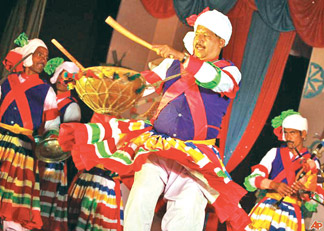Male dominating folk dances of India
Subashini PATHMANATHAN
The folk theatre of India is a combination of dance and drama mixed
with vocal music and a different variety of musical instruments. This
folk theatre is very popular among the village masses and tribes. Yet
this folklore is a colourful entertainment-based on history, tradition,
religion and social customs. Some folk dances are connected to religious
functions, religious festivals and some are agricultural functions such
as harvest.
|
Folk theatre
* Drama mixed with vocal and different music instruments
* Some are performed by only males
* Mostly based on ancient epics
* Widely practised in Tamil Nadu |
 |
|
Therukoothu
in Tamil Nadu is quite popular |
Some of the folk dances are performed by males alone, and some of the
folk dances are performed only by the females, and some are performed by
males and females together. Some states of India have theme-based annual
seasonal folk dance dramas like Ramlila.
Therukoothu in Tamil Nadu is quite popular basically based on ancient
epics. The theme of the story is sung by the actors and dialogue take
place in between the play. Distinct make-up and costumes are adopted and
even the female roles are played by the males.
Similarly Purravai Aattam or Poei Kal Kutherai Aattam (dummy horse
dance) is one of the traditional male folk dances of India. In this
dance form horses are made out of paper or colourful cloths with
glittering golden or silver borders. Through a slit in the back the man
appears.
The men dress up themselves as grooms and hold swords in their hands.
They dance to the accompaniment of the Nathaswara musical band. This is
a common dance form during the religious functions and festive seasons.
Another male dance form is Oyilaattam or Oyil Kumi Aattam which is
widely practised in Tamil Nadu by men. Oyil Kumi during the Thai Pongal
festival the men hold the handkerchiefs and dance; the men form two rows
in equal number and dance. It is a dance performed by the men alone
therefore it resembles beautiful attractive majestic Thandava stances.
Kavadi Attam is another folk dance mainly practised by men folk but
some kavadis like Paal (milk) Kavadi is performed mainly by the women
which are totally associated with temple festivals. But Paravai Kavadi
is performed by men alone during the temple festivals.
Sillampattam is another fork art practised by men from the Chola
period. It is based on martial art methods and is used for self defence.
Devaraattam is widely practised in Tamil Nadu by a clan called Kampala
Nayakar. An instrument called Devathunthurki (a drum) is used in this
dance.
It is claimed that there are 103 adavus which are called Aattam, in
Devar Aattam. There is another dance form called Servai Aattam. It is
practised by the same clan. Bhangra is the most popular dance form of
Punjab. Steady firm and vigorous movements could be seen. The drummer
plays the important role, he occupies the central position and the
others (the dancers) form a circle around him and dance. The drummerís
beating is accompanied with the singing by one or two singers in this
art form. The verses for the dance are often taken from the Punjabi
poetry called Boli or Dhola.
The drummer plays the drum (dhola) with sticks, first the drums
beating start with slow tempos and lead with fast tempos. The dress for
this dance is pure Punjabi dress including dhoti, beautiful colourful
turban, waist coat and kurta.
Chhau, dance is another form of dance which exists in three different
regions of India. The Chhau dance practised in West Bengal is called
Serikala Chhau which is a very vigorous martial art and suitable for
males only. Royal patronage was given to this art form.
Even the princes were not only dancers, but excellent mask makers
also. Purulia Chhau, exists in the south east of Orissa which is
considered as a highly tribal area.
Various factors were responsible for the formation of this art form,
such as Hindu religious mythology, vedas, tribal customs and martial
art. The theme of the art conveys the triumph of good over evil.
In Kerala, Kuddiaattam and Chakiar Koothu both are performed by the
male dancers.
However, all these male dance forms are more entertaining and
colourful.
|



